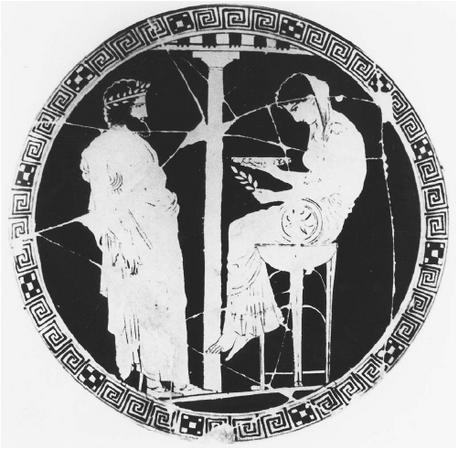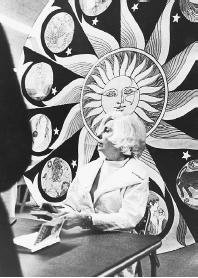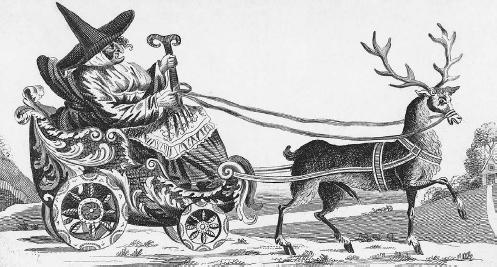PROPHETS AND DIVINERS
Thousands of years before the contemporary era, wise men and women listened while murmuring springs and streams spoke to them of what was to be, and they looked through the brilliance of precious stones into the world of tomorrow. Trees spoke to these early mediators between the gods and humans, as did the wise serpent, the wolf, and the birds that flew overhead.
Many centuries later, Chaldean priests contemplated the night sky and conceived the idea of a supreme spirit from whom sprang a familiar host of lesser deities. In the aftermath of this modification of the traditional order of things, a caste of priests arose, vested with all knowledge of the occult. Subsequently these priests became adept in the practice of divination, finding signs in the organs and intestines of sacrificed animals and translating dancing shapes of flames and swirls of smoke into images of future events. When the gods spoke directly to individuals in the symbolic language of dreams, the priests were there to interpret. In these and other ways, the will of the cosmic rulers was revealed to their earthbound subjects.
The children of Israel, even though they spurned the hordes of good and evil spirits recognized throughout the ancient world, practiced divination in several forms. The book of Genesis records that Laban, the father of Rachel, who became the wife of Isaac, possessed Teraphim—instruments of divination whose oracles were held to be of the highest truth.
Although the practice of sorcery and divination was forbidden to the Hebrews, the high priests of Israel inquired of the Lord regarding the future by means of the high priests' jeweled Ephod and the Urim and Thummim. When the Lord failed to speak to him through the Ephod, Saul (11th century B.C.E.), first king of Israel, resorted to necromancy, or divination through the spirits of the dead. Saul entreated the fabled Witch of Endor to call up the spirit of the great prophet Samuel, only to hear his own death foretold. According to tradition, Solomon (10th century B.C.E.), wisest of all the Hebrew monarchs, foretold the future by consulting demons, which he summoned with his magic lamp and great seal.
The Sphinx, the guardian of Egyptian magic, served as an oracle for diviners of that land. According to Plutarch, such thinkers as Solon, Thales, Pythagoras (c. 580–c. 500 B.C.E.), and Lycurgus traveled to Egypt to converse with priests who heard the voice of the Sphinx. Ancient magi solemnly testified that the statues of Egypt spoke, and when these oracles of hewn stone uttered their pronouncements, scribes wrote their words on rolls of papyrus while priests listened.
The Greeks saw in numbers the mystical keys to the Great Mind of the cosmos; and the fates of kingdoms, commerce, and human lives hung on the enigmatic utterances of the Delphic oracle. A Greek sect called the psychagogues conjured the spirits of the dead, who brought petitions for their survivors as well as prophetic messages. With so many deities to keep track of, it is no wonder that the Greeks were ever on the alert for omens, even in such simple phenomena as birds in flight and the sequence in which a fowl picked up kernels of grain. Socrates (c. 470–399 B.C.E.) foretold the future with the aid of his own familiar spirit, which replied to yes-and-no questions with sneezes to the right or to the left.
The Roman emperors, while officially forbidding divination, rewarded Chaldean astrologers with drachmas when their readings were favorable and with death or exile when they found adverse omens in the stars. Even the early Christian Church, which persecuted magicians and soothsayers, found that the use of crosses, beads, and relics and bones of the saints were useful aids in bringing the faithful into a state of mind in which the voice of the Holy Spirit might be heard.
All human cultures throughout history have given great attention to their prophets and seers. Perhaps the quintessential prophet is Nostradamus (1503–1566), whose name has become synonymous with prophecy and who is better known to the general public than any of the Old Testament prophets. The French seer has inspired numerous books, countless articles, and a number of television specials. Although his visions of the future were written in poetic verse and read like gibberish to the skeptics, those who believe firmly in Nostradamus's gift of prophecy quote his predictions as if they were Holy Writ. The claim that Nostradamus had predicted the tragedy of the World Trade Center terrorist attack on September 11, 2001, was widely circulated on the Internet and on talk radio. The alleged prediction was soon exposed as a hoax, but not before thousands of books on Nostradamus were sold.
The twentieth century produced a number of prophets who gathered their believers and provoked their disbelievers, but none received the mass attention of Edgar Cayce (1877–1945), the famous "sleeping prophet" of Virginia Beach, and Jeane Dixon (1918–1997), Washington, D.C.'s "window on the world." Although there will always be seers who will produce an occasional startling prophecy that comes to pass and attract transient devotees until the next prophet comes along with an even more startling prediction, the trend at the onset of the twenty-first century appears to be individuals relying upon their own powers of prophecy and the insights gained from utilizing their own methods of divination.
DELVING DEEPER
Cotterell, Arthur, ed. Encyclopedia of World Mythology. London: Dempsey Parr Books, 1999.
Gaskell, G. A. Dictionary of All Scriptures & Myths. Avenel, N.J.: Gramercy Books, 1981.
Seligmann, Kurt. The History of Magic. New York: Pantheon Books, 1960.
Spence, Lewis. An Encyclopedia of Occultism. New Hyde Park, N.Y.: University Books, 1960.
DELVING DEEPER
Boltan, Brett, ed. Edgar Cayce Speaks. New York: Avon Books, 1969.
Carroll, Robert Todd. "Edgar Cayce." InThe Skeptic's Dictionary. [Online] http://skepdic.com/cayce.html.
Cayce, Hugh Lynn. Venture Inward. New York: Paperback Library, 1966.

Cerminara, Gina. Many Mansions. New York: William Morrow, 1950.
Stearn, Jess. Edgar Cayce—The Sleeping Prophet. New York: Doubleday, 1967.
Sugrue, Thomas. There Is a River: The Story of Edgar Cayce. New York: H. Holt and Co., 1942.
DELVING DEEPER
Cotterell, Arthur, ed. Encyclopedia of World Mythology. London: Dempsey Parr Books, 1999.
De Boer, J. Z., J. R. Hale, and J. Chanton. "New Evidence of the Geological Origins of the Ancient
Delphic Oracle." Geology 29 (2001): 707–710.
Gaskell, G. A. Dictionary of All Scriptures & Myths. Avenel, N.J.: Gramercy Books, 1981.
Piccardi, L. "Active Faulting at Delphi, Greece: Seismotectonic Remarks and a Hypothesis for the Geologic Environment of a Myth." Geology 28 (2001): 651–54.
Seligmann, Kurt. The History of Magic. New York: Pantheon Books, 1960.

DELVING DEEPER
Bringle, Mary. Jeane Dixon: Prophet or Fraud? New York: Tower Books, 1970.
Carroll, Robert Todd. "Jeane Dixon and the Jeane Dixon Effect." InThe Skeptic's Dictionary, [Online] http://skepdic.com/dixon.html. 20 May 2002.
Delfano, M. M. The Living Prophets. New York: Dell Books, 1972.
Montgomery, Ruth. A Gift of Prophecy: The Phenomenal Jeane Dixon. New York: Bantam Books, 1966.
"Psychic Jeane Dixon Dies—'Astrologer to Stars' Had Legions of Believers." CNN Interactive, January 26, 1997. [Online] http://www.cnn.com/SHOW-BIZ/9701/26/dixon/index.html. 20 May 2002.

DELVING DEEPER
Hughes, Irene. ESPecially, Irene: A Guide to Psychic Awareness. Blavelt, N.Y.: Rudolf Steiner Publications, 1972.
Irene Hughes. [Online] http://www.irene-psychic.com. 29 May 2002.
Steiger, Brad. Know the Future Today. New York: Paperback Library, 1970.
DELVING DEEPER
Psi-Stjarna. [Online] http://paranormal.se/topic/olof_jonsson.html. 23 November 2002.
Margaret Harrell's website. [Online] http://www. marharrell.com/Pages/NDonO1.html.
Seagrave, Sterling. The Marcos Dynasty. New York: Harper & Row, 1988.
Steiger, Brad. The Psychic Feats of Olof Jonsson. Englewood Cliffs, N.J.: Prentice-Hall, 1971.
DELVING DEEPER
Cheetham, Erika. The Final Prophecies of Nostradamus. New York: Berkley Publishing Group, 1990.
Crockett, Arthur. Nostradamus: Unpublished Prophecies the Untold Story. New Brunswick, N.J.: Inner Light, 1983.

Hogue, John. Nostradamus: The Complete Prophecies. Element Books, 1997.
Randi, James. The Mask of Nostradamus: The Prophecies of the World's Most Famous Seer. Buffalo, N.Y.: Prometheus Books, 1993.
Seligmann, Kurt. The History of Magic. New York: Pantheon Books, 1948.
DELVING DEEPER
Shipton, Mother. Mother Shipton's Fortune Teller; Or, Future Fate Foretold by the Planets. New York: Padell Book Co.: 1944.
Harrison, W. H. Holmes. Mother Shipton Investigated. The Result of a Critical Examination of the Extant Literature Relating to the Yorkshire Sybil. London: Holmes Publishing Group LLC: 2001.
Windsor, Diana. Mother Shipton's Prophecy Book: The Story of Her Life and Most Famous Prophecies. London: Wolverson Publishing: 1988.
Weed, Joseph J. Complete Guide to Oracle and Prophecy Methods. New York: Parker Publishing. 1975.
Glass, Justine. They Foresaw the Future. The Story of Fulfilled Prophecy. New York: G. P. Putnam's Sons. 1969.

Comment about this article, ask questions, or add new information about this topic: